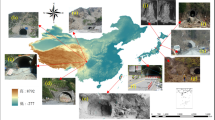Abstract
According to the slippage of the slope under the action of strong earthquakes and the deformation of the lining structure of the diversion water tunnel, the hydropower station under the seismic load with a 100-year probability of exceeding 2% was simulated, and the three-dimensional dynamic finite element method was used to analyze the slope of the powerhouse and the diversion water tunnel, and obtained the stress and displacement laws of the slope and the water diversion tunnel lining structure and the dynamic response characteristics of the tunnel. The results showed that under the influence of ground motions, the slope and the lining structure of the diversion water tunnel would produce similar forced vibrations, and the damage effect at the top of the slope was more obvious than that at the empty face. The dynamic displacement, tensile stress and compressive stress increased with the increase of the peak ground motion. The maximum values of tensile and compressive stress of the tunnel lining structure appeared at the entrance of the upper flat section of the diversion water tunnel, and there would be local tensile stress concentrations at the top, bottom and the middle of the tunnel. Due to the existence of adjacent tunnels, the tensile stress generated by the tunnel lining was asymmetric in the horizontal direction, and the mutual influence between the two tunnels increased the maximum tensile stress accordingly.









Similar content being viewed by others

References
Cui JH, Chen YQ, Gong YQ, Qi YF (2013) Seismic analysis of auxiliary powerhouse of Mitsong hydropower station. Hydropower Energy Sci 31(12):106–108 (in Chinese)
Guo SS, Li DY (2013) The effect of dynamic elastic modulus changes on the dynamic response of arch dams. J China Inst Water Resour Hydropower Res 11(2):125–129 (in Chinese)
Hu FX (2006) Earthquake engineering. Seismological Press, Beijing ((Monograph))
Jiang YZ, Xu WY, Wang RB, Shi C, Zhang ZL (2009) Dynamical time-history analysis of Xiaowan Arch Dam and its safety assessment. Hydropower 35(5):56–59 (in Chinese)
Li YS, Shan W, Li JH (2010) Study on substructure pseudo-dynamic test. China CivEng J 43(3):119–123 (in Chinese)
Liu JB, Liu XQ, Du XL (2007) Prospects for the development in theoretical analysis and experimental study of seismic response of underground structures. EarthqEngEngVib 27(6):38–45 (in Chinese)
Ministry of Water Resources of the Peopl’s Republic of China (2013) SL 616- -2013. Prototype observation specification for hydraulics of water conservancy and hydropower engineering. China Water Resources and Hydropower Press, Beijing (in Chinese)
Pan JW, Zhang CH, Xu YJ (2010) Influence of seismic input mechanism and foundation models on response of gravity dams. Chin J GeotechEng 32(1):82–87 (in Chinese)
SL203-97 (1998) Code for seismic design of hydraulic structures. Water Resources and Electric Power Press, Beijing (in Chinese)
Wu XF, Sun QG, Di JJ, Zhou YC (2011) A numerical simulation comparison between response spectrum analysis and time history analysis. Northwest Seismol J 33(3):275–304 (in Chinese)
Yang RJ, Liu SZ, Cheng Z (2017) Comparison analysis between response displacement method and seismic coefficient method used in calculation of seismic response of metro tunnels. Railw Constr 6:68–72 (in Chinese)
Youssef MAH, Jeffray JH, Schmidt B, Yao JI-C (2001) Seismic design and analysis of underground structures. TunnUndergr Space Technol 16(4):247–293
Zhang BY, Li DY (2014) Dynamic stability analyses of Baihetan hydropower-station left slope. EngMech 31(1):149–153 (in Chinese)
Zhang LH, Tao LJ (2002) Analysis of seismic dynamic response of jointed rock mass underground caverns. World EarthqEng 18(2):158–162 (in Chinese)
Zhang TY, Xie YT (2006) Practical method of the adjusted earthquake wave. Build Struct 1:55–56 (in Chinese)
Acknowledgements
This work was supported by Excellent Talents Fund Program of Higher Education Institutions of Liaoning Province (No. LR2018053) and the National Natural Science Foundation of China (51774199).
Author information
Authors and Affiliations
Corresponding author
Additional information
Publisher's Note
Springer Nature remains neutral with regard to jurisdictional claims in published maps and institutional affiliations.
Rights and permissions
About this article
Cite this article
Wang, Z., Li, B. Stability Analysis of Slope and Diversion Water Tunnel of Hydropower Station under Strong Earthquake. Geotech Geol Eng 39, 2041–2049 (2021). https://doi.org/10.1007/s10706-020-01605-x
Received:
Accepted:
Published:
Issue Date:
DOI: https://doi.org/10.1007/s10706-020-01605-x



